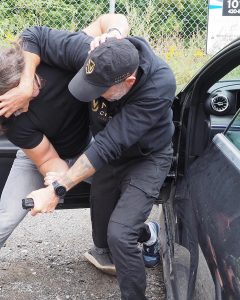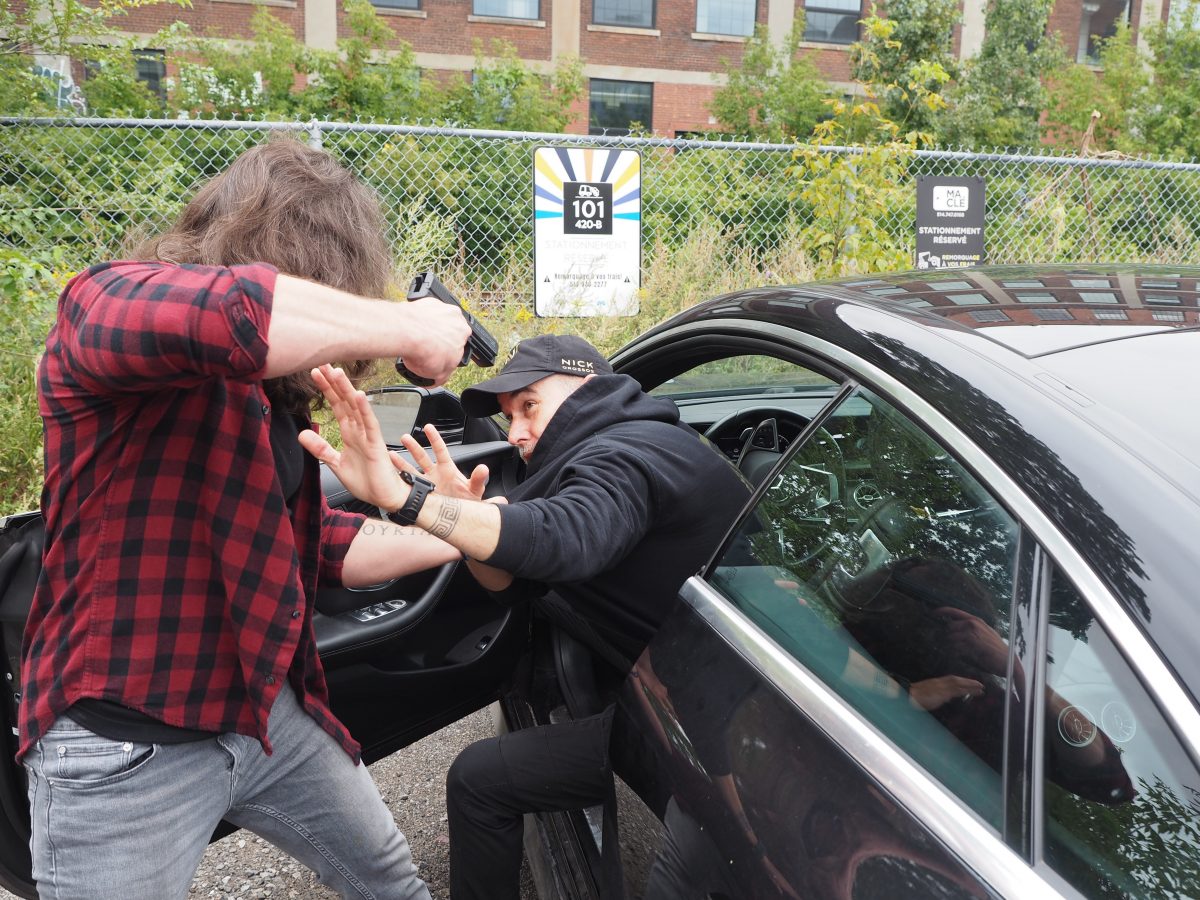A Carjacking is part of a disturbing trend and earns its claim of media attention with headlines publicizing a spree of brutal episodes, but is it enough to shake us? It’s a brutal premeditated crime in which the perpetrator is armed and uses violence or the threat of violence while demanding your vehicle. It’s punishable by death if the victim is killed, but how does it even get to that point?

FACT: 90% of carjackings involve a firearm or weapon
Countless victims report not seeing the carjacker until the gun barrel was in their face. In extreme cases, they are oblivious until the instant they’re physically pried from their vehicle. Carjackings are fast and desperate, leaving victims traumatized, injured, or dead.
SIGN UP TODAY! THE MOST CUTTING-EDGE AND REALISTIC GUN DISARM TECHNIQUES IN THE INDUSTRY!
What exactly makes you a possible casualty or soft target? What type of scenarios drive this type of violent criminal to act? How can you defend yourself from carjackings? And can you train for survival? The answers to these questions and the premise of this blog are to offer tips and boost insight into carjackings and safety. The feral crime has spiked, making an alarming resurgence, so with this in mind, let’s get you armed.
FACT: 92% of carjackings happen when the victim is alone in the car
Although carjacking can transpire anywhere, there are some places they are more apt to occur. Ready or not, some locations are not avoidable, so for that reason, it’s vital to identify them to instill vigilance, and carefulness. This is yet another avenue of situational awareness. It’s important to point out that the carjacker wants to catch you by surprise and overpower you, but it makes it nearly impossible when you’re on the move. A violent attack is more liable if you are stopped at a traffic light or parked.
VIDEO: THE REALITY OF GUN DEFENCE IN A CARJACKING!
Be sharp in these physical scenarios
- High crime areas
- Deserted or less traveled roads
- Mandatory stop intersections
- Isolated zones of parking lots
- Residential driveways and gates
- Traffic jams and congestion
The Art of Stopping
A typical scenario that involves sitting in your vehicle, looking down at your phone, and remaining stationary could prove to be threatening, even fatal. It’s critical to enter and exit your vehicle quickly. Even proximity to your ride could forge a moment of attack. Keeping some distance between you and the driver ahead is also valuable if you need to maneuver out quickly.
Although, when you are stopped at a traffic light, it’s vital to use your rear and side mirrors to stay alert to your situation – with windows up and doors locked. This heightens your chances of safety and could be the very thing that deters a violent attack.
FACT: 63% of carjackings ensue within 5 miles from home
The parking lots of shopping centers and fast food restaurants are hot spots for carjackings, even during daylight hours. Honking your home or activating the key fob if you see someone approaching your vehicle is smart. The chirping noise of the car unlocking system will at least draw attention to your location.
When parking your vehicle, it’s an effective defense to scan your environment to assess whether there are bushes, trees, or tempting barriers for a violent attacker to hide behind. Selecting a well-lit spot is not apt to coax a carjacker to approach you. Also, If you park in your garage, it’s excellent to make a habit of locking the door immediately upon entering – keep in mind, a carjacker may be ducking into your perimeters.
FACT: Carjackers are usually under the age of 21
It’s Not Always an Accident
An accident to a carjacker is a scenario for making you an easy target and in their control. There are four typical methods that will grant him a prime opportunity to get you to stop and then violently steal your vehicle. Ultimately, the aim is to put you in a vulnerable position.
The bump: This trickery is when the carjacker bumps into your vehicle from behind. The moment you exit your vehicle to assess the damage or exchange information is when the violent scenario ensues.
The good samaritan: In this scenario, the carjacker stages what appears to be an accident or even simulates an injury. The violent robbery incites when you stop to help out.
The ruse: This deception occurs when the carjacker drives behind your vehicle and flashes its lights or waves to get your attention, often par for the course when a driver encounters problems on the road. Their tactic is to snare you into pulling over and offer a boost or a jack for a flat.
The trap: This type of carjacking is boldly personal, as the carjacker uses surveillance to follow you home. Once you’ve reached your driveway, waiting for your entry gate to open, the attacker will pull up from behind and block your vehicle

Neutralizing a Carjacking
Non-resistive:
Knowing that carjackers are often paired and typically only want your vehicle is pivotal. This could be effective knowledge to help you remain calm – knowing you stand a chance. Be wary that staring directly at your attacker may be understood as aggression and consequently provoke being harmed.
Additionally, making sudden movements may be construed as defiance or resistance. Your survival could depend on keeping your hands visible and advising your attacker of any and every move you will make before you make it. It’s imperative to listen meticulously to all directions made by the vicious criminal.
If you have your children in the car, remember that a carjacker may be too focused on your actions to realize you may not be alone. Announce that they are with you and never allow a carjacker to get behind the wheel of your vehicle with your children still inside. Nor, should you ever comply with your attacker if he demands you get inside with him.
DEFEND AGAINST A CARJACKING: CHECK OUT BULLET PROOF TACTICAL GUN DEFENSE HERE!

Resistive:
Being driven to a second location with a carjacker is catastrophic and you should fight for your life. Use improvised weapons, and aim for vulnerable zones such as the eyes, groin, and chin. Gouging, hitting, smashing and kicking are all fair game when it comes to survival – there are no rules or mercy.
Blog: The Body Opponent Bag: How BOB Could Save Your Life
If you’re armed – know how to use your gun, and ensure you are prepared to use it. It’s a sound idea to practice using it in your vehicle precisely where the carjacking will transpire – your movement will be restricted with limited space. Learning how to access your firearm, aim, and shoot is not second nature and demands a certain level of expertise. This is urgent in saving your own life and possibly the lives of others.
FACT: 90% of carjackings are committed against a single victim
Preparing and training for a carjacking is paramount in self-defense instruction. My real-world expertise will mobilize you to physically and mentally prepare you to respond to threats of violence. You’ll learn how to diffuse, defend and to take control in this type of perilous scenario. Deciding whether to escape or attack a carjacker should ultimately be contingent on the mental state of the attacker, if there are more than one involved in the crime, possible avenues of escape and the existence of weapons – notably a gun or firearm.
FACT: 45 % of attempted carjackings are successful
Giving up your vehicle is always the safest choice – it’s vital to understand this type of crime is not your regular car theft; a carjacker’s motive is to execute the atrocity face to face, and violence is surefire.
 Teaching prevention, detection, and ultimately setting up for the initial strike to be one step ahead of the attacker, will always be in hardcore demand. My Knife Defense, Hero Program, Hero Training Camp, Bob Dummy F.I.I.T, Women’s Shield Program, Bully-Proof, and Larger Attacker Defense are dynamic systems indicative of real-world self-defense to sustain personal protection. Which one will empower you?
Teaching prevention, detection, and ultimately setting up for the initial strike to be one step ahead of the attacker, will always be in hardcore demand. My Knife Defense, Hero Program, Hero Training Camp, Bob Dummy F.I.I.T, Women’s Shield Program, Bully-Proof, and Larger Attacker Defense are dynamic systems indicative of real-world self-defense to sustain personal protection. Which one will empower you?


